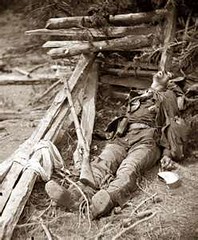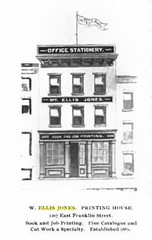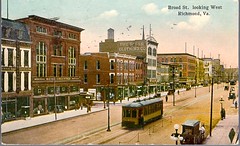A month or so back I signed up, via Coursera, to take a 10 week long class at the University of Pennsylvania on the “History of the Slave South”. Since this is one of my favorite subjects of study – a passion, no less – I’ve been anxiously awaiting the start of the class. It began today and I was absolutely astonished to find that there are people from all over the world taking this course. Folks from Australia, New Zealand, German, Spain, and England all enrolled in class dealing exclusively with the unique flavor of slavery that flourished in the Southern Colonies (and later States) of North America. Fascinating!
Today I completed my first assignment; write a brief piece in response to the question, “How was your nation or region shaped by the slave trade?”
Here’s my response:
CH Jones – Resident of Raleigh, North Carolina, U.S.A. / Native of Southside Virginia, Nottoway & Roanoke River Valley Region.
My home region was not only shaped by the Transatlantic slave trade, it was and in many respects, still is, completely defined by antebellum slavery – socially, politically, economically, and culturally. Volumes have been written – with many more yet to be written – about the specifics of economics and historical impact on the region. In regards to social and cultural impact, we’ve only begun to scratch the surface.
In the latter part of the 18th century and early 19th century, issues of race and class distinction began to take on great significance in Virginia and North Carolina. In this period there emerged a great fear of “free” blacks – often highly skilled, moderately well educated, and surprisingly autonomous in their physical as well as social movement – “mixing with” and exciting the upward ambitions of both enslaved blacks and lower class (often indentured, or nearly so) whites.
Upper class whites; those who most directly benefitted from a hardened, legally legitimized institution of slavery, in combination with a rigid, near-feudal caste system which kept most whites equally outside the civil and economic sphere of decision making and economic power, saw themselves as a “pure” and superior race who were destined by God to rule. They saw the mixing of races and the aspirations of lower class whites as a direct threat to their divinely ordained place at the top of society.
And yet, despite myriad laws and regulations passed throughout the 18th and 19th centuries to separate both races, classes, and even sexes, despite sophisticated “divide and conquer” psychologies used to pit poor-whites against free and enslaved blacks, despite entrenched religious justifications used to perpetuate slavery and the social caste status-quo – the “aristocracy” of the south failed to maintain and perpetuate a stratified society in which silos of race, gender, and class coexisted, separately.
Their failure is evident in every respect of the “southern antebellum” culture that arose in the 19th century, matured in the years immediately before and after the Civil War, went underground during the closing decades of Reconstruction, and then began to openly flourish beginning in the years immediately following WWI – and which thrives today openly and unapologetically, despite the lack of self-awareness of many of its most enthusiastic practitioners and beneficiaries – or its most ardent opponents.
I am a white descendant of Planation owning slaveholders. This morning my alarm clock shook me awake to the sound of Aretha Franklin belting out her now famous, and hardly demurring “Respect”; a song which, at every level, flies in the face of what the upper class, white, male social engineers of 18th and 19th century Virginia attempted to institutionalize.
When I arose from bed I showered – alone. There was no servant there to bath me, dress me, or do my hair. In fact my hair requires very little “doing”, as I wear it very short – much like the female slaves of the 19th century were required to do, as their masters found African hair unruly and offensive. So I find my own hair when it gets too long. I crop it close.
My clothing includes indigo blue dyed denim jeans (indigo being a hugely profitable crop in the plantation south, it’s cultivation, production, and application imported to the Colonies by slaves in the 19th century) – not silk or lace or taffeta. I wear flat soled work boots – not slippers or heels. I make my own coffee and I take out my own garbage.
The language I use is infused with regionalisms informed by generation upon generation of exchange between white and black and mixed race neighbors. For breakfast I’ll “crack a guinnea into my pone” (eggs & grits.) For dinner I will “cook up a mess of collards.” When I go to work I won’t leave until “I’ve hoed to the end of the row.” When I get in trouble I’m “in the stripes” (a reference to flogging or whipping.) When I’m almost done with a monolithic task, I’m, “working the short rows.” When I’m unexpectedly fortunate, I’m “shittin’ in high cotton.”
When I head out for an evening’s entertainment in Raleigh, I’ll likely venture downtown to the City Market area. There, surrounded by street musicians of every color and creed, I’ll hear strains of blues, reggae, “beach music” (a unique North/South Carolina blend of African inspired blues combined with country “dance” music), rap and hip-hop, all played out in the open air on cobbled sidewalks and streets that once hosted the weekly slave market auctions, held in this place, more than one hundred years before I was born.
Depending upon my mood, I can step into any number of restaurants offering Caribbean fare, soul-food, or low-country Creole. Inside these establishments patrons – black, white, Latino, and otherwise – mix and comingle without the least awareness of the “failed” culture in which they live.
They eat, sleep, dance, and make love together. They work side by side. They love and hate one another with undifferentiated passion – rarely based on skin color or even class – usually having to do with more common human complaints of ambition, desire, and greed.
Meanwhile, a mixed race man of half-African, continental descent sits in the “White House” (which was built entirely by slaves), and contemplates how to heal a deeply divided, racist nation that can’t seem to work through its racist history. Despite his concerns, the movie “12 Years a Slave” sits poised to sweep the academy awards, demonstrating that America may finally be paying attention to its past, after all.
The culture that thrives in my community demonstrates that Virginia, the South, and the nation as a whole – despite its many successes and social, civil advances – is the Greatest Epic Failure in the history of the western world.
Thank God.
















You must be logged in to post a comment.